Are you looking for best through the wall exhaust fan to keep your kitchen, bathroom cool and well-ventilated? Look no further than a through the wall exhaust fan!
The right exhaust fan can make cooking and cleaning in your kitchen more efficient and much more pleasant. You’ll enjoy fresher air and better peace of mind knowing that smoke, steam, odors, and other airborne particles are being safely vented out of your home.
Through the Wall Exhaust Fans
Through the wall exhaust fans are designed to be installed into wall openings near restrooms, laundry rooms and other areas for ventilation. Most are equipped with a motor that exhausts air through duct work that is connected on the outside of your home or business. These units provide good general ventilation and can help to remove smoke and moisture from your living area.
Benefits of a Through the Wall Exhaust Fan
A through the wall exhaust fan is a great choice when you are looking to improve the ventilation in your home. These type of fans are installed through an exterior wall and help to draw out stale, moist air while bringing fresh air into your home and providing a more comfortable living environment all year long. Here are some of the key benefits of installing a through the wall exhaust fan in your home:

1. Reduced humidity and moisture levels
By removing humidity and reducing mold and mildew, it can help to prevent deterioration of fabrics, furniture, carpeting, and window treatments. Not only does reducing humidity help remove unpleasant odors from the air but it also helps to prevent mold growth on walls or ceilings. This is especially important when it comes to maintaining a healthy indoor environment as mold spores can cause allergies and other respiratory problems.
2. Improved air quality
Through the wall exhaust fans bring fresh air from outside into living spaces promoting air circulation throughout the entire house. Through the wall exhaust fans are designed to pull air from within a structure and expel it outwardly, creating fresh ventilation and helping to keep indoor air free from harmful contaminants.
3. Versatility
They can be used for both intake or exhaust depending on your specific needs and location. They can be used as either an intake or exhaust fan depending on your specific needs and location. For instance, if you want to draw cool air from outside during the summer months, you could use it as an intake fan.
Considerations When Buying a Through the Wall Exhaust Fan
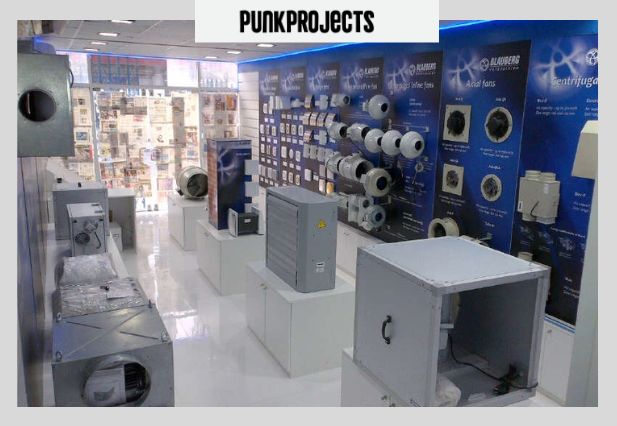
When selecting a through the wall exhaust fan, there are several considerations you should take into account. It is important to consider the size of the exhaust fan, as well as any special features you may need such as an integrated light or timer. You will also want to think about noise level or CFM ratings. It is important to choose the right exhaust fan for your space and specific needs.
1. Features
Through the wall fans can come with a variety of additional features such as an integrated light, timer, adjustable speed controls or motion sensors. Depending on your space and needs, these features may be helpful in controlling humidity levels or making the fan easier to use.
2. Noise Level
The noise level of your through the wall exhaust fan should also be taken into consideration when choosing a model. If you need a quiet model, look for ones that have sound dampening materials used in their construction such as thick plastic housing and foam seals around moving parts that can significantly reduce noise levels when operating at higher speeds.
3. CFM Ratings
CFM stands for cubic feet per minute and indicates how much air at what rate your through-the-wall fan can remove from its environment – so it determines how effective it will be at ventilating spaces like bathrooms and kitchens. Generally speaking, higher CFM ratings indicate more powerful fans with greater ventilation performance capabilities- though higher prices tend to follow suit too!
Top Rated Through the Wall Exhaust Fans
Finding the perfect through the wall exhaust fan for your specific needs is an important decision. There are many great models on the market, all with their own set of features and styles, making it essential that you take some time to research and find a unit that fits your exact requirements. To help narrow down the selection of fans, we’ve picked out a few of the top rated models currently available.
Panasonic FV-08WQ1
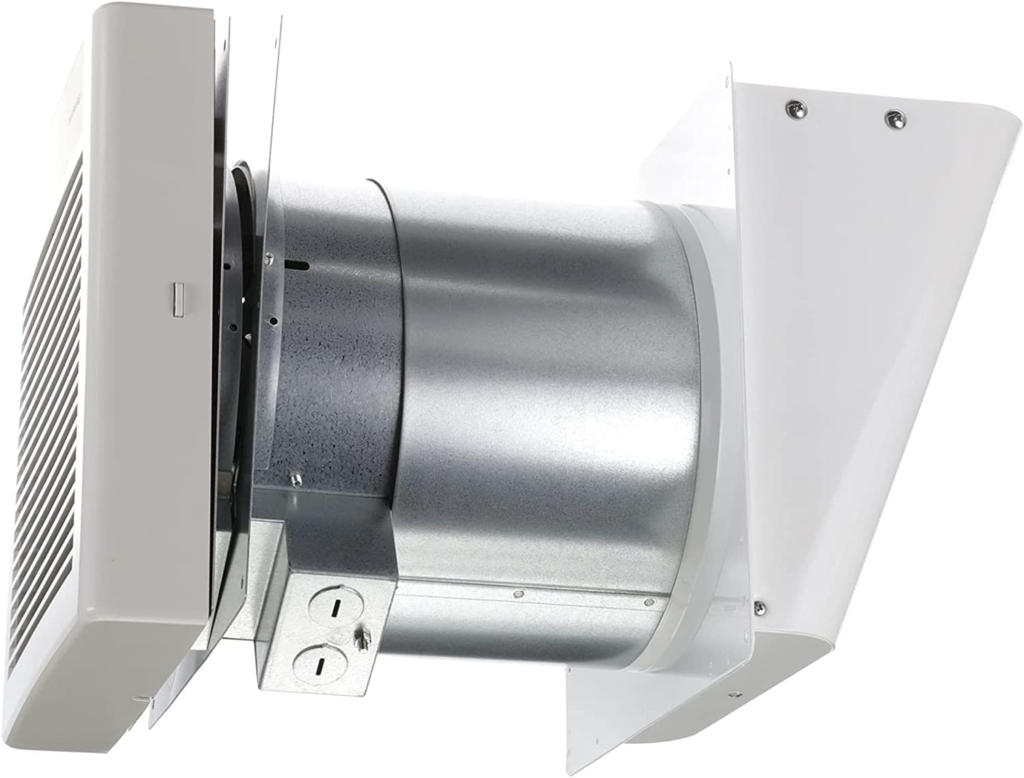
Panasonic’s WhisperWall fan is ideal for providing ventilation in rooms where a standard ceiling-mounted model is not a possibility. The WhisperWall operates as a through-the-wall type in locations where installation on the floor is not an option. WhisperWall comes with a wall box and includes a galvanized sleeve. In order to meet code requirements, it has been updated in recent years.
Broan-NuTone 512M
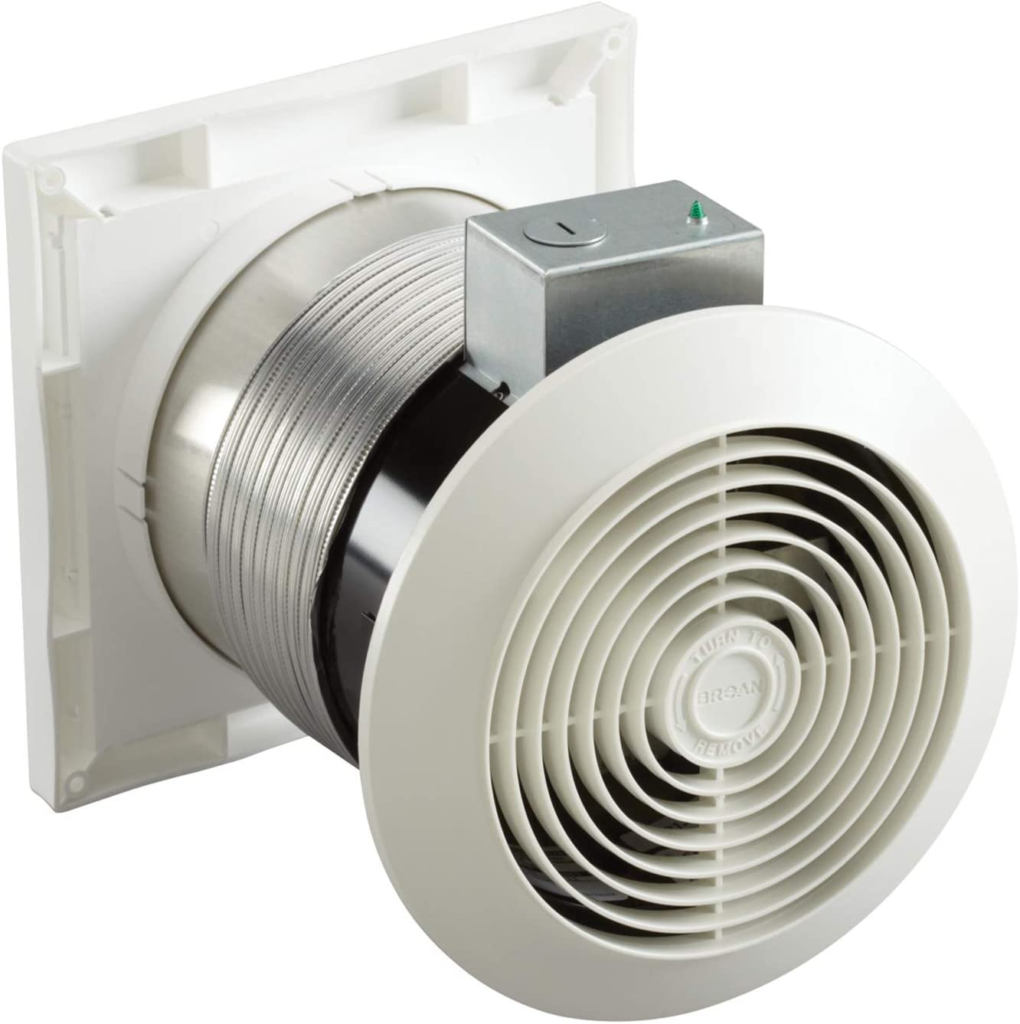
The Broan CFM Through-Wall Ventilation Fan boasts a powerful motor that fits conveniently in a compact space, making it perfect for a single-car garage or for spot ventilation near areas such as a work bench, garbage can, car, or lawnmower. The galvanized steel housing withstands repairs and maintenance.
Broan-NuTone 509S
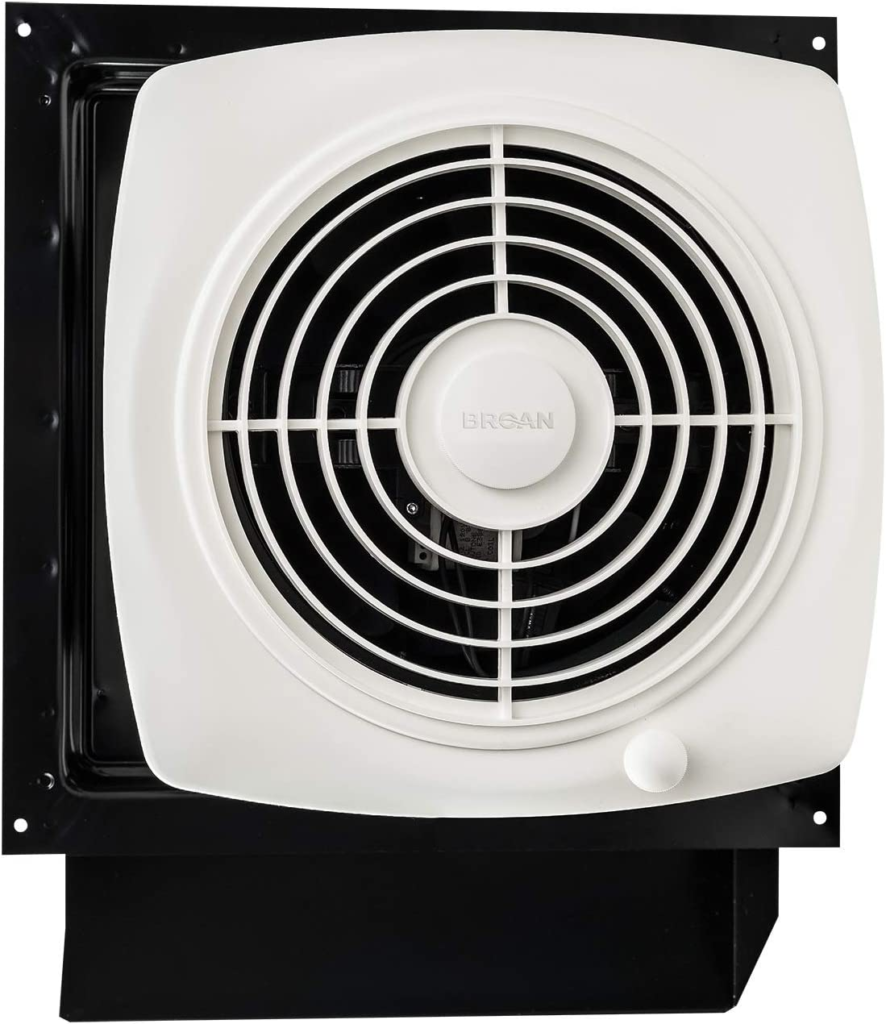
The Broan Nautilus 180 CFM direct-discharge fan can remove moisture from laundry rooms, tobacco smoke from recreation rooms, and workshop waste, as well as cooking smells from kitchens. The fan is capable of expelling 180 cubic feet of air per minute at 6.5 Pascals, and the housing adjusts to fit walls 4-1 by 2-to 9-1 inches thick. The fan includes a built-in damper to minimize backdrafting.
AC Infinity AIRLIFT S10

Designed for sheds, attics, and workshops, the AC Infinity AIRLIFT S10 Shutter Exhaust Fan 10″ is the perfect ventilation and cooling solution. With an EC Motor and a speed controller, it provides powerful air movement in any environment. The strong aluminum construction ensures durability while its easy installation makes it ideal for any space.
KEN BROWN Exhaust Fan
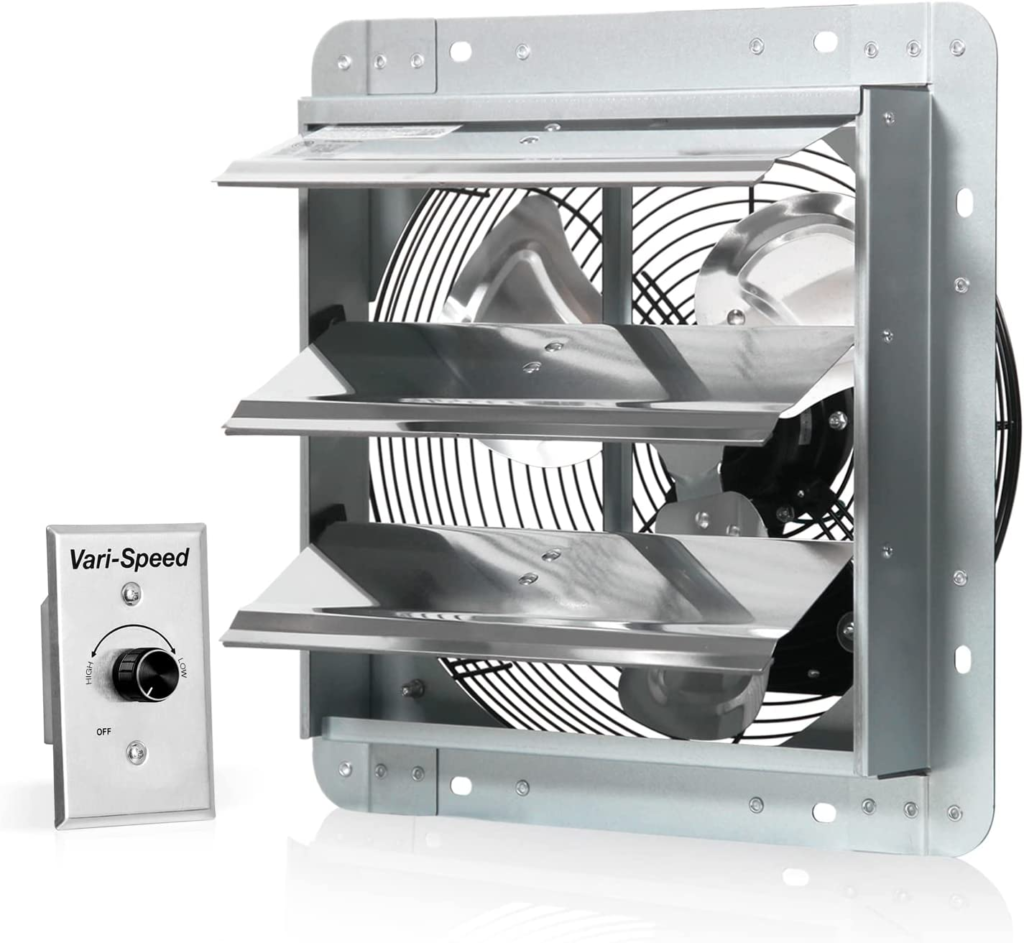
The KEN BROWN 12 Inch Shutter Exhaust Fan is a versatile and powerful fan that can be used to remove heat, moisture, dust and unpleasant odors from any residential, commercial or industrial environment. The fan has a 120-Volt motor with an adjustable speed of up to 2200 RPMs. Its unique design allows it to be mounted on either the wall or ceiling for maximum ventilation power.
Installation of a Through the Wall Exhaust Fan
A through the wall exhaust fan and vent cap is necessary to ensure that your indoor air quality remains safe and healthy by venting excess moisture, cooking odors, and other airborne pollutants out of your home or business. Installing a through the wall exhaust fan requires prior planning to ensure proper sizing and placement of the fan, as well as the vent cap, for maximum efficiency.
It is essential to determine the size of exhaust fan that is appropriate for your space. The primary factor to consider when selecting a fan size is the cubic footage of the space in which it will be installed.
Generally speaking, an exhaust fan with a capacity rating in CFM (cubic feet per minute) should be used for rooms under 100 square feet; a room over 500 square feet could require multiple fans based on bathrooms needing up to 128 CFM or living spaces up to 416 CFM.
Maintenance of a Through the Wall Exhaust Fan

Periodic maintenance is important with a through the wall exhaust fan to ensure it is operating at optimal performance. Here are some easy tips for maintaining your wall fan:
• Periodically inspect for dirt, dust, and debris build-up in the fan system. Clean periodically to avoid impeding air flow or causing damage to the unit.
• Check seals around the wall or window opening where your fan is installed at least once every few months to confirm that they are tight and not leaking air. This will reduce energy bills by reducing interior drafts.
• Check the ventilation louver in front of your fan regularly throughout the year to make sure it’s free of dirt and debris that may impair its ability to open and close properly.
• If you have an outdoor mounted drain tube, ensure it is free of debris, clogging, and snow buildup as these can affect efficiency adversely when trying extend lifespan and get maximum performance out of your through the wall exhaust fan unit.
• Replace filters every few months depending on usage, local conditions, and amount of incoming pollutants (pollen/pollution). A dirty filter can significantly lower airflow performance from any exhaust system; thus regular replacements will be required.
Alternatives to Exhaust Fans
Though exhaust fans are the primary way of providing ventilation in many buildings, they are not the only option. In some cases, natural ventilation strategies can provide an effective and energy-efficient alternative to the traditional exhaust fan setup. Mechanical and non-mechanical strategies for moving air from one point to another include:
1. Mechanical Strategies
- Wind Towers: Utilizing a tall structure, wind towers can pull in outside air from up high and push out hot stale air from lower windows.
- Thermal Chimneys: These structures use interior heat as a form of natural convection to draw fresh air up through an intake duct and out through higher exit points.
2. Non-Mechanical Strategies
- Cross Ventilation or Natural Stacking Effect: This approach involves orienting building openings in such a way that the inside air is drawn out when warm air rises or blown away when cold air descends, providing natural ventilation.
- Louvers & Grilles: These features can be installed into otherwise sealed walls or ceilings to provide access for outside air to enter while still allowing an effective barrier against dust, insects and other unwanted materials entering into the building.
Frequency Ask Question
How to Choose a Bathroom Exhaust Fan?
Bathroom exhaust fans are an important part of any bathroom’s ventilation system. Not only do they help prevent damage from moisture and help control the temperature, but they also eliminate odors and airborne bacteria.
When choosing a bathroom exhaust fan, there are several factors to consider such as size, type, noise level, and installation requirements.
Can you vent an exhaust fan through a wall?
Venting an exhaust fan through a wall is possible with the right equipment. Modern through-the-wall exhaust fans are built to be installed in a wall rather than in a window or ceiling, making them perfect for bathrooms and kitchens located away from any exterior walls. They feature features like weatherproofed designs, speed controls and even motion sensors.
How to Choose a Kitchen Exhaust Fan?
When it comes to choosing a kitchen exhaust fan, there are a few key points to consider. First of all, decide what type of fan you need. Wall-mounted fans are great for larger kitchens and feature an adjustable speed setting that helps control the amount of air being drawn out from the area.
Remote-controlled fans offer convenience and can be installed in any room since they do not require hardwiring into an electrical box. Furthermore, consider the size of the exhaust fan — bigger rooms necessitate more powerful models to ensure that all smoke and odors are thoroughly dispersed.
Is it better to vent bathroom fan through roof or wall?
Venting your bathroom fan through a roof may seem like the best option when you first consider it. By venting through the roof, air is expelled away from any nearby windows or other doors – meaning constituents in the air won’t be drawn back into another room downstairs or nearby.
This means your home will remain fresher, longer and with little chance of any unpleasant odors. Additionally, if there are any guests staying over they can use the bathroom without having to worry if they’ll be noticed from outside.
Which is better ventilation fan or exhaust fan?
When it comes to deciding between a ventilation fan and an exhaust fan, the type of fan you need for your space will depend on the particular needs of that area. Ventilation fans bring fresh air into a space, known as make-up air. This kind of fan is beneficial if you live in a region with high humidity levels or in areas that tend to be stuffy and uncomfortable.
Exhaust fans are used to draw stale, hot air out and provide better airflow throughout living spaces. They can also help move contaminants (such as smoke) outside the area they’re used in, making them ideal for kitchen cooktops or bathrooms.
What is the difference between extractor fan and exhaust fan?
Exhaust fan installations normally come with a duct system that hauls air from that area to the outer atmosphere outside the building, releasing it directly into the environment. It is utilized for ventilation purposes and should be installed through an external wall.
Extractor fans are commonly used for kitchen or bathroom purposes and depending on your needs or budget, can lie in between quiet exhaust fans with dampers and more powerful exhaust fans with motors.
The main benefit of an extractor fan is its ability at removing any unwanted steam, smoke, moisture and nauseous odors from these small spaces without allowing airborne contamination to re-enter the house.
Conclusion
Ultimately, through-the-wall exhaust fans provide an effective way to improve indoor air quality. Homeowners should consider their location, size, and noise levels when making a purchase to ensure that the fans are the best fit for the space.
In addition to constructing the best wall opening for efficient efficiency, it is also important to regularly clean and maintain your through-the-wall exhaust fan. With a little bit of preparation, installing one of these fans can be a great way to create better ventilation in your home and reduce the buildup of contaminants.
I am a multi-talented designer and contractor with over 10 years of experience in the field. I have a passion for creating beautiful, innovative spaces that reflect my clients’ needs and styles. My skills include architectural design, interior design, space planning, project management and construction supervision.






